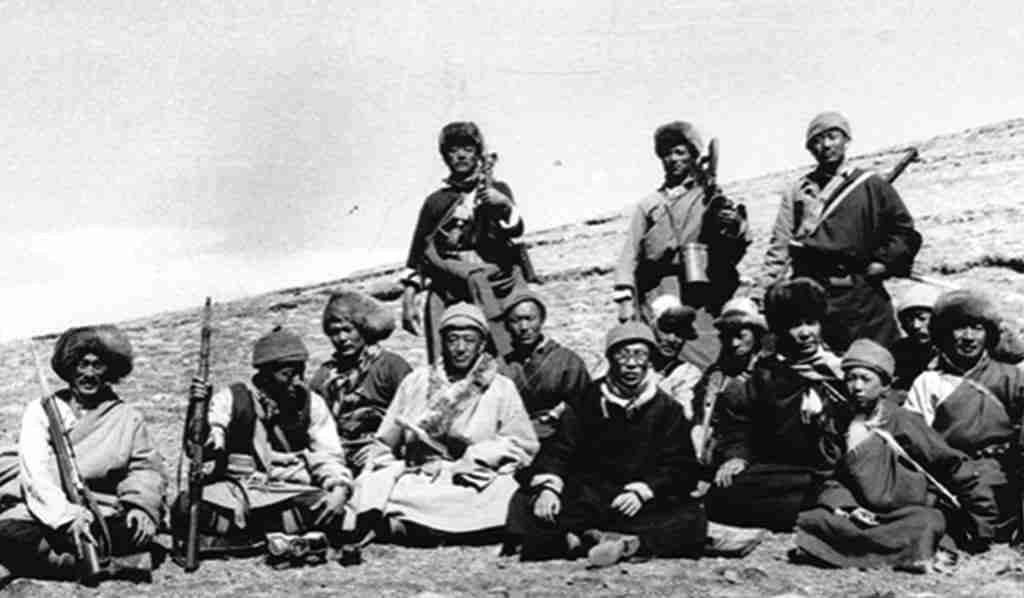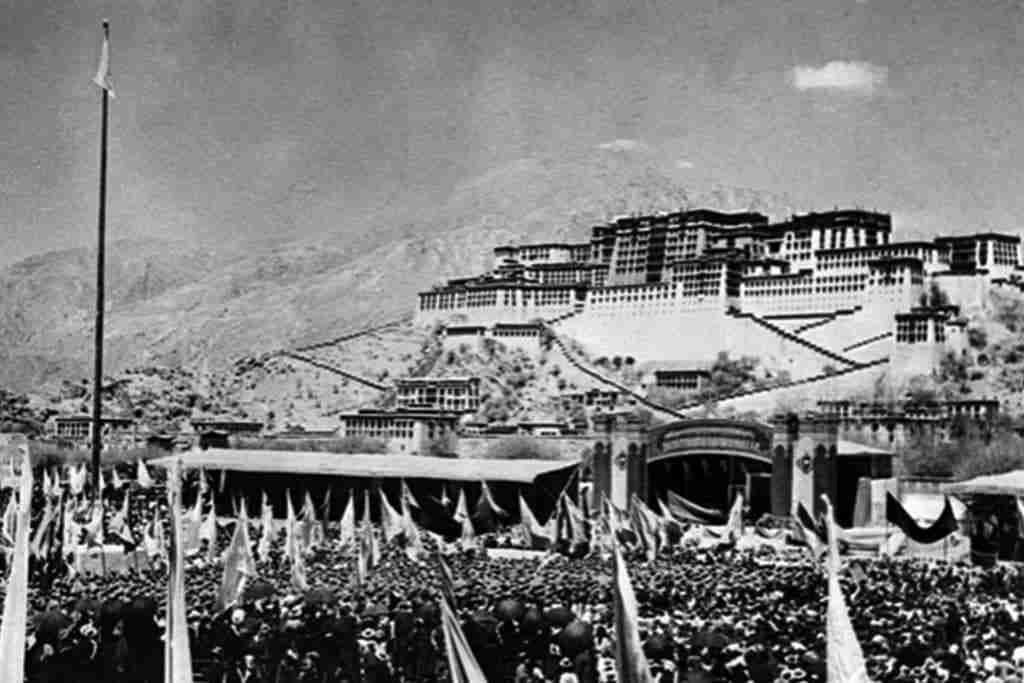On March 10, 1959, the Dalai Lama, received a seemingly innocuous invitation: Chinese general Zhang Chenwu asked if the 14th Dalai Lama would like to see a performance by a Chinese dance troupe. Soon after, he received a message asking him to come to the Chinese military headquarters without soldiers or armed bodyguards. The Tibetans, who had already been suspicious of the sudden friendly overture, sensed a trap. On the day of the performance, thousands of Tibetan protesters surrounded Norbulingka (part of Potala Palace, Dalai Lama’s residence in Lhasa) to keep their young leader from being abducted, arrested or killed.
As a precautionary measure, the Dalai Lama’s closest advisers also asked him to escape from Tibet. Filled with despair, he eventually did. On the night of March 17, 1959, Tibet’s 23-year-old spiritual and political head disguised himself as a soldier and quietly slipped through the crowds surrounding his summer palace in Lhasa, a place that he would never see again. Accompanying him were 20 of his officials (cabinet members and soldiers) and his family (his mother and younger siblings).
Thus began Dalai Lama’s perilous journey to asylum. Traveling only at night to avoid detection by Chinese sentries, the group made their way across the arduous Himalayan region on foot, included crossing the 500 yard wide Brahmaputra River. During the day, they would hide in nondescript lamaseries, tiny villages and encampments of the native Khamba tribe.
A journey like no other
For the next two weeks, there was no word of the Tibetan leader and people around the world feared that he had been killed. In Tibet, as per the 1959 cover story of the TIME magazine, rumours floated about that the Dalai Lama “had been screened off from the view of Chinese planes by mist and low clouds conjured up by the prayers of the Buddhist holy men.”
Meanwhile, back in Lhasa, the Chinese had imposed a curfew and nearly 2000 lives were lost in the ensuing battle between the locals and the Chinese forces. Soon after, close to 800 artillery shells were fired into Norbulingka. A day later, China dissolved the Tibetan governing body and announced the establishment of a Tibetan Autonomous Region within the People’s Republic of China.
By this time, furious Chinese troops were in hot pursuit of the escaping Tibetan leader. They had gradually started closing on him when on March 26, 1959, his fleeing caravan finally reached Lhuntse Dzong — a few days march from the McMahon Line, the border between India and Tibet.
From here, he sent an urgent letter to Nehru seeking refuge in India: Forewarned, the Indian government immediately took measures to welcome and ensure the protection of Dalai Lama and his party. PN Menon (who had served as India’s Consul General in Lhasa) was also sent along with Assistant Political Officer (APO) to Chuthangmu, a tiny Assam Rifles outpost near Tawang, to do the same.

And so, on March 31, 1959, the Dalai Lama fought his way through wind-whipped peaks and snow-covered plateaus to finally reach the homeland of the Buddha. Clad in weather-beaten clothes yet instantly recognisable among the small entourage, the Tibetan leader was welcomed by Indian officials who handed him a telegram from the Indian Prime Minister: “My colleagues and I welcome you and send greetings on your safe arrival in India. We shall be happy to afford the necessary facilities to you, your family and entourage to reside in India. The people of India, who hold you in great veneration, will no doubt accord their traditional respect to your personage. Kind regards to you. Nehru.”
Soon after, the Dalai Lama and his family were escorted to Tawang to rest and recuperate from the strains of the arduous journey. In his biography, he mentions that he was looked after very well by the family of Bomdila’s local District Commissioner. A few weeks later, Dalai Lama travelled to Mussoorie in present day Uttarakhand, where he was met by Nehru who formally welcomed him and offered him asylum. The two of them also discussed the future of the nearly 80,000 Tibetan refugees who had followed their leader into exile.
Clad in weather-beaten clothes yet instantly recognisable among the small entourage, the Tibetan leader was welcomed by Indian officials who handed him a telegram from the Indian Prime Minister.
Soon after, Dalai Lama established the Tibetan government-in-exile in Dharamsala (now known as Little Lhasa). For the Tibetans who had followed him, it was a bittersweet moment they would remember for a long time—they had escaped Chinese occupation but had also lost their beloved homeland.
The rest, as they say, is history. The Dalai Lama has since never gone back to Tibet and continues to be the centre of the Tibetan community, the person to whom the Tibetans look for guidance in practically all matters. Even today, visitors to Lhasa report that the residents turn south and bow to offer salutations to their revered leader. Looking back at the journey this story is about, Dalai Lama’s gruelling two-week trek across the Himalayas to asylum in India has been by far the most dramatic visit by any foreign leader. As Dalai Lama himself has often pointed out, he is the “longest guest of the Indian government.”
5 Assam Rifles escorts Dalai Lama
The Dalai Lama’s entry into India was through the Frontier post of Chuthangmu in Kameng Division from where he was safely escorted by 5 Assam Rifles personnel to the plains of Assam. Following the Dalai Lama’s flight to India, the frontier post of Chuthangmu, Bumla and Chuna were faced with a mass ingress of Tibetan refugees called Khampas, all of whom had to be disarmed before being allowed to proceed further. The Battalion through the Kameng Frontier Division escorted approximately 12,000 refugees. In Subansiri Frontier Division, the newly opened isolated posts of Longju and Taksing had to deal with the same refugees’ ingress, though to a lesser degree.

Following the flight of the Dalai Lama international relations between India and China became quite strained. Chinese moved up troops into the India-China border and claimed vast areas of Indian Territory both in Kameng and Subansiri Frontier Division. The border outpost of 5 Assam Rifles at Longju in Subansiri Division was evacuated after an armed clash with vastly superior Chinese force in August 1959. It was then decided to concentrate the battalion in the Kameng Frontier Division.
In March 2018, Havildar Naren Chandra Das (retired) one of the 5 Assam Rifles troops who escorted the Dalai Lama in India in 1959 after his escape from Tibet met him again. The Dalai Lama got emotional as he embraced Das.

“I feel blessed once again as His Holiness touched me and bumped his head with my head,” Das told reporters after he was honoured by the leader at an event in Dharamsala to mark the 60th anniversary of the Dalai Lama’s arrival in India. Das said he was overwhelmed by the gesture of His Holiness for inviting him. The event marked the onset of a year-long ‘Thank You India’ campaign.
Union Culture Minister Mahesh Sharma, Members of Parliament Shanta Kumar and Satyavrat Chaturvedi were also present at the event along with functionalities of the Central Tibetan Administration (CTA), comprising its President Lobsang Sangay.It was in 2017, that Das was reunited with the Dalai Lama for the first time in 58 years at a festival organised by the Assam government.
Das, who joined the force in 1957, said he was one of those in the detachment of troops to escort the Dalai Lama along with other Tibetans. “We were directed only to escort the Dalai Lama and not to speak with him,” said Das. He was then posted at Lungla near the China border after having completed his training at Tawang in the then North East Frontier Agency, now Arunachal Pradesh, he said.


